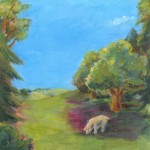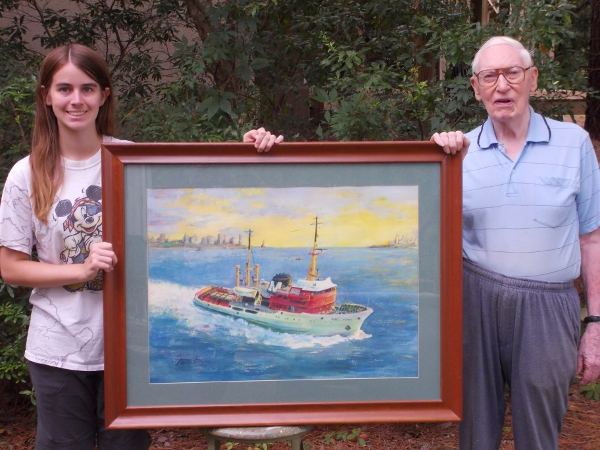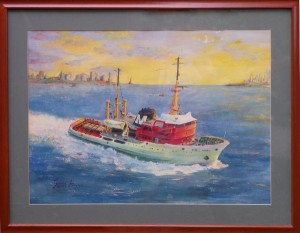And very distinguished ones, too.
Alice Moran:
She’s finished! No photo this time–I’ll wait until she’s framed.
Illustration:
Do You Have a Pebble in Your Pocket? (the goat book) is coming along slowly but surely. All the spreads are beyond the base layers of paint and, for the most part, unified in their color and value (light & dark) schemes. There are a few stowaways that I’ll bring into harmony with the rest. (What is that sea foam green doing in the middle of a tree?) Then I can think more about details as I brush up my rendering skills.
And because I’m sure you’re all curious about what the duodecimo happens at a haiku conference…
Haiku-coo for Cocoa Puffs:
First, let me say that last weekend was surprisingly successful! Hard to believe it was already a week ago. Made some contacts, sold a few books, wrote lots of haiku, discovered figgyhobbin… (We’ll see how many comments that garners.)
Friday was casual–registration, reception, a group reading of haiku by three poet-scholars they were honoring at the festival, followed by an open reading (for anyone to share). Let me say that when I stood up to share two poems I had penned that very evening, I did not expect 1) enthusiastic applause, 2) that I’d end up the rising star of the conference. I mean that in a very humble way. Throughout the weekend, several attendants (including some top-tier people) shared how much they enjoyed my haiku and that I had a very natural, intuitive sense. In fact, Sunday before I left, two ladies of the Haiku Society of American (HSA) conferred and said that to keep me writing, they would see about using the HSA scholarship fund to gift me a membership (and some HSA haiku journals) through 2015. This has been confirmed with the president of the HSA. I’m quite honored.
Back to the schedule. Saturday consisted of several workshops on different genres incorporating haiku (eg., haibun, which is short prose followed by haiku, and haiga, which pairs art and haiku), talks on the development and status of haiku, and more reading. Sunday, the group took a ginko (not to be confused with the Chinese ginkgo tree), which is a walk to gather inspiration for haiku, had lunch, and held a final reading.
Now that I’ve learned a few more things about haiku, I’ll expand upon my syllabic comments from last time (for your edification and enjoyment, if not my duty as a new HSA member). Haiku is, of course, brief, and it juxtaposes images, traditionally two concrete images, at least one of which pertains to nature or the seasons. Modern haiku and senryu often incorporate abstract or subjective images or ideas, too, such as an emotion. Both forms include incomplete grammar or syntax and a kire (“cut”), simply a pause or caesura, which aids juxtaposition (and may create an “aha!” moment).
Animal Art:
Since this post is getting quite long, I’ll keep this short. My panda project, Pandagrams, is well underway. Stay tuned to learn just what that includes. I also completed a portrait of a Norfolk terrier I dogsat about two weeks ago; scoot over to the Animal Art portfolio to see it.




